BIM Visual Programming Tools Applications in Infrastructure Projects: A State-of-the-Art Review
Abstract
Featured Application
Abstract
1. Introduction
- (1)
- Dynamo; This VP tool is associated with Autodesk Revit software and is the most commonly used by the AECO project industry [49]. A number of scholars have used this VP tool; for example, Valinejadshoubi et al. [50] developed an algorithm to record data from a set of facilities to BIM models. This platform was used to record real-time data of facilities of a residential building in the city of Ottawa (Canada). Santoni et al. [51] applied an algorithm that optimizes the visualization of BIM model elements in a heritage project in the city of León (Spain).
- (2)
- Grasshopper: This is a plug-in developed by Robert McNeel & Associates for the Rhinoceros 3D modeling software [52,53]. Among the scholars that have used this VP tool, the following can be highlighted. Abbasi et al. [54] developed a parametric simulation platform to study the energetic performance in projects. The proposed platform was used to measure the energy relationships in an industrial assembly project in Shiraz (Iran). Freitas et al. [55] proposed an algorithm for estimating solar energy capture for photovoltaic projects in the city of Brasilia (Brazil). Massafra et al. [56] studied the behavior of wooden structures of various heritage projects in Bologna (Italy) through 3D surface scanning. Then, the scanned data was connected to BIM models using interoperable VP scripts.
- (3)
- Python; It is a programming language developed by Van Rossum [57]. Initially, this language was as open source. Then, it was integrated with the BIM environment via the development of application programming interfaces (APIs). APIs are applications that create algorithms that allow the communication of two or more software packages [58]. Authors working with APIs include Kensek (2018) [59], who developed a VP educational module for BIM energy development projects. This module was applied in architecture courses in the city of Los Angeles (US). Martinez et al. [60] proposed an automated control algorithm to inspect modular units on industrial assembly projects. This algorithm was used in various residential projects in Canada. Andriamamonjy et al. [61] created an automated deployment of an air treatment system for construction sites using an integrated platform between building performance simulation (BPS) and BIM models. Then, this platform was implemented in several facilities’ management projects in Belgium.
- (1)
- Friendly interface [66]; This technological tool offers an interactive interface for AECO professionals without advanced knowledge in programming. This advantage has been studied by Saito et al. [67], who compared both visual and line-of-text (conventional) programming languages for beginning students. The methodology proposed in this study used programming operations in video games of basic mathematical operations and logic processes to study students’ responses. This study showed that VP offered a more intuitive interface for beginning students due to the positive impact that visual schemas had on programming learning.
- (2)
- Reducing modeling time [68]; VP tools can create parametric figures through different scripts to associate model design information with automatic geometry generation processes, thus reducing modeling time. This benefit was illustrated by Kensek [69], who studied the interoperability of BIM model information flows in solar façade projects by comparing the following two methodologies: (1) Using VP algorithms; These scripts were used as a bridge to allow the transfer of information between BIM and energy models, which were developed independently. (2) Using Industry Foundation Class (IFC) files; These data packages are the most popular interoperability format in the BIM environment. These files were used to update both BIM and energy models through IFC native files. Both methodologies were applied in building projects in California (US), showing that visual algorithms were more efficient in transferring information between BIM and energetic models.
- (3)
- Automation of repetitive processes [70]; Such as naming project drawings with a specific nomenclature. This advantage was illustrated by Nezalmaldin [71], who studied the automation provided by the VP algorithms of the Dynamo tool in the conversion of CAD drawings to BIM models. For this purpose, he compared his results with those of the conventional CAD-BIM manual conversion methodology. This benefit was validated using different buildings in the city of Stockholm (Sweden).
- (4)
- Providing connectivity with non-BIM software [72]; VP tools provide a bridge between a variety of software types (such as Microsoft Excel and Access) and BIM models. This advantage is illustrated in Boeykens et al. [73], who evaluated the interoperability between CAD and BIM models in architectural projects. In this study, a Python algorithm was developed to connect the information of the BIM model with Excel spreadsheets, extracting the information of urban surfaces and spaces. This evaluation was applied to a digital reconstruction project of a synagogue in the city of Vienna (Austria).
2. Materials and Methods
3. Results and Discussion
3.1. General Results Analysis
3.2. Analysis of Results by Topic of the Papers
4. Conclusions
Author Contributions
Funding
Institutional Review Board Statement
Informed Consent Statement
Data Availability Statement
Conflicts of Interest
References
- Carvalho, J.P.; Bragança, L.; Mateus, R. Sustainable building design: Analysing the feasibility of BIM platforms to support practical building sustainability assessment. Comput. Ind. 2021, 127, 103400. [Google Scholar] [CrossRef]
- Sidani, A.; Dinis, F.M.; Sanhudo, L.; Duarte, J.; Santos Baptista, J.; Poças Martins, J.; Soeiro, A. Recent Tools and Techniques of BIM-Based Virtual Reality: A Systematic Review. Arch. Comput. Methods Eng. 2019, 28, 449–462. [Google Scholar] [CrossRef]
- Santos, M.C.F.; Costa, D.B.; Ferreira, E.D.A.M. Information workflow proposal for integrating cost estimating, scheduling, and monitoring with BIM in SMEs. Ambiente Construído 2021, 21, 113–129. [Google Scholar] [CrossRef]
- Bellido-Montesinos, P.; Lozano-Galant, F.; Castilla, F.J.; Lozano-Galant, J.A. Experiences learned from an international BIM contest: Software use and information workflow analysis to be published in: Journal of Building Engineering. J. Build. Eng. 2019, 21, 149–157. [Google Scholar] [CrossRef]
- Hong, S.-H.; Lee, S.-K.; Kim, I.-H.; Yu, J.-H.; Hong, L.; Kim, Y. Acceptance model for mobile building information modeling (BIM). Appl. Sci. 2019, 9, 3668. [Google Scholar] [CrossRef]
- Martins, S.S.; Evangelista, A.C.J.; Hammad, A.W.A.; Tam, V.W.Y.; Haddad, A. Evaluation of 4D BIM tools applicability in construction planning efficiency. Int. J. Constr. Manag. 2020, 1–14. [Google Scholar] [CrossRef]
- Staub-French, S.; Pilon, A.; Poirier, E.; Fallahi, A.; Kasbar, M.; Calderon, F.; Teshnizi, Z.; Froese, T. Construction process innovation on brock commons tallwood house. Constr. Innov. 2021, 8, 1471–4175. [Google Scholar] [CrossRef]
- Jang, J.; Ahn, S.; Cha, S.H.; Cho, K.; Koo, C.; Kim, T.W. Toward productivity in future construction: Mapping knowledge and finding insights for achieving successful offsite construction projects. J. Comput. Des. Eng. 2021, 8, 1–14. [Google Scholar] [CrossRef]
- He, R.; Li, M.; Gan, V.J.; Ma, J. BIM-enabled computerized design and digital fabrication of industrialized buildings: A case study. J. Clean. Prod. 2021, 278, 123505. [Google Scholar] [CrossRef]
- Lamptey, T.; Owusu-Manu, D.-G.; Acheampong, A.; Adesi, M.; Ghansah, F.A. A framework for the adoption of green business models in the Ghanaian construction industry. Smart Sustain. Built Environ. 2020. [Google Scholar] [CrossRef]
- Li, X.-J.; Lai, J.-Y.; Ma, C.-Y.; Wang, C. Using BIM to research carbon footprint during the materialization phase of prefabricated concrete buildings: A China study. J. Clean. Prod. 2021, 279, 123454. [Google Scholar] [CrossRef]
- Tushar, Q.; Bhuiyan, M.A.; Zhang, G.; Maqsood, T. An integrated approach of BIM-enabled LCA and energy simulation: The optimized solution towards sustainable development. J. Clean. Prod. 2021, 289, 125622. [Google Scholar] [CrossRef]
- Nguyen, D.K.; Huynh, T.L.D.; Nasir, M.A. Carbon emissions determinants and forecasting: Evidence from G6 countries. J. Environ. Manag. 2021, 285, 111988. [Google Scholar] [CrossRef] [PubMed]
- Harvey, N.; Pearce, I. At what cost is collagenase clostridium histolyticum viable for treating Peyronie’s disease in a public healthcare system? Andrology 2020, 8, 1304–1311. [Google Scholar] [CrossRef]
- Toepfer, S.; Zhang, T.; Wang, B.; Qiao, Y.; Peng, H.; Luo, H.; Wan, X.; Gu, R.; Zhang, Y.; Ji, H.; et al. Sustainable pest management through improved advice in agricultural extension. Sustainability 2020, 12, 6767. [Google Scholar] [CrossRef]
- Lee, W.-I.; Chiang, N.-C. An investigation of the methods of logicalizing the code-checking system for architectural design review in New Taipei city. Appl. Sci. 2016, 6, 407. [Google Scholar] [CrossRef]
- Lee, Y.; Kim, I.; Choi, J. Development of BIM-based risk rating estimation automation and a design-for-safety review system. Appl. Sci. 2020, 10, 3902. [Google Scholar] [CrossRef]
- Prizeman, O.; Pezzica, C.; Taher, A.; Boughanmi, M. Networking historic environmental standards to address modern challenges for sustainable conservation in HBIM. Appl. Sci. 2020, 10, 1283. [Google Scholar] [CrossRef]
- Macher, H.; Landes, T.; Grussenmeyer, P. From point clouds to building information models: 3D semi-automatic reconstruction of indoors of existing buildings. Appl. Sci. 2017, 7, 1030. [Google Scholar] [CrossRef]
- Maskuriy, R.; Selamat, A.; Ali, K.N.; Maresova, P.; Krejcar, O. Industry 4.0 for the construction industry—How ready is the industry? Appl. Sci. 2019, 9, 2819. [Google Scholar] [CrossRef]
- Jiang, S.; Jiang, L.; Han, Y.; Wu, Z.; Wang, N. OpenBIM: An Enabling Solution for Information Interoperability. Appl. Sci. 2019, 9, 5358. [Google Scholar] [CrossRef]
- Miano, A.; Fiorillo, A.; Salzano, A.; Prota, A.; Jacobsson, R. The structural design of the decay volume for the search for hidden particles (SHIP) project. Arch. Civ. Mech. Eng. 2021, 21, 3. [Google Scholar] [CrossRef]
- Viana, V.L.B.; Carvalho, M.T.M. Prioritization of risks related to BIM implementation in brazilian public agencies using fuzzy logic. J. Build. Eng. 2021, 36, 102104. [Google Scholar] [CrossRef]
- Lee, Y.-J.; Jun, H.-J. Development of a BIM-based carbon dioxide emission estimation system-focus on an apartment in Korea-. Arch. Res. 2016, 18, 145–149. [Google Scholar] [CrossRef]
- Liu, S.; Meng, X.; Tam, C.M. Building information modeling based building design optimization for sustainability. Energy Build. 2015, 105, 139–153. [Google Scholar] [CrossRef]
- Jun, H.; Lim, N.; Kim, M. BIM-based Carbon Dioxide Emission Quantity Assessment Method in Korea. J. Asian Arch. Build. Eng. 2015, 14, 569–576. [Google Scholar] [CrossRef]
- Zhou, H.; Azar, E.R. BIM-based energy consumption assessment of the on-site construction of building structural systems. Built Environ. Proj. Asset Manag. 2019, 9, 2–14. [Google Scholar] [CrossRef]
- Wu, P.; Xia, B.; Zhao, X. The importance of use and end-of-life phases to the life cycle greenhouse gas (GHG) emissions of concrete—A review. Renew. Sustain. Energy Rev. 2014, 37, 360–369. [Google Scholar] [CrossRef]
- Xu, J.; Shi, Y.; Xie, Y.; Zhao, S. A BIM-Based construction and demolition waste information management system for greenhouse gas quantification and reduction. J. Clean. Prod. 2019, 229, 308–324. [Google Scholar] [CrossRef]
- Chhatwani, M.; Golparvar-Fard, M. Model-driven management a of construction carbon footprint: Case study. In Proceedings of the Construction Research Congress 2016, San Juan, PR, USA, 31 May–2 June 2016; pp. 1202–1212. [Google Scholar]
- Marzouk, M.; Abdelkader, E.M.; Al-Gahtani, K. Building information modeling-based model for calculating direct and indirect emissions in construction projects. J. Clean. Prod. 2017, 152, 351–363. [Google Scholar] [CrossRef]
- Sánchez, A.; González-Gaya, C.; Zulueta, P.; Sampaio, Z.; Torre, B. Academic proposal for heritage intervention in a BIM environment for a 19th century flour factory. Appl. Sci. 2019, 9, 4134. [Google Scholar] [CrossRef]
- Xie, L.; Wang, R.; Ming, Z.; Chen, D. A layer-wise strategy for indoor as-built modeling using point clouds. Appl. Sci. 2019, 9, 2904. [Google Scholar] [CrossRef]
- Adibfar, A.; Costin, A.; Issa, R.R.A. Design copyright in architecture, engineering, and construction industry: Review of history, pitfalls, and lessons learned. J. Leg. Aff. Disput. Resolut. Eng. Constr. 2020, 12, 04520032. [Google Scholar] [CrossRef]
- Ivson, P.; Moreira, A.; Queiroz, F.; Santos, W.; Celes, W. A systematic review of visualization in building information modeling. IEEE Trans. Vis. Comput. Graph. 2019, 26, 3109–3127. [Google Scholar] [CrossRef]
- Panah, R.; Kioumarsi, M. Application of building information modelling (BIM) in the health monitoring and maintenance process: A systematic review. Sensors 2021, 21, 837. [Google Scholar] [CrossRef]
- Boton, C.; Rivest, L.; Ghnaya, O.; Chouchen, M. What is at the Root of Construction 4.0: A Systematic Review of the Recent Research Effort. Arch. Comput. Methods Eng. 2021, 28, 2331–2350. [Google Scholar] [CrossRef]
- Liu, Z.; Chi, Z.; Osmani, M.; Demian, P. Blockchain and building information management (BIM) for sustainable building development within the context of smart cities. Sustainability 2021, 13, 2090. [Google Scholar] [CrossRef]
- Sepasgozar, S.M.E.; Shi, A.; Yang, L.; Shirowzhan, S.; Edwards, D.J. Additive manufacturing applications for industry 4.0: A systematic critical review. Buildings 2020, 10, 231. [Google Scholar] [CrossRef]
- Artus, M.; Koch, C. State of the art in damage information modeling for RC bridges—A literature review. Adv. Eng. Inform. 2020, 46, 101171. [Google Scholar] [CrossRef]
- Zhang, J.; Zhao, L.; Ren, G.; Li, H.; Li, X. Special issue “digital twin technology in the AEC industry”. Adv. Civ. Eng. 2020, 2020, 1–18. [Google Scholar] [CrossRef]
- Samimpay, R.; Saghatforoush, E. Benefits of implementing building information modeling (BIM) in infrastructure projects. J. Eng. Proj. Prod. Manag. 2020, 10, 123–140. [Google Scholar] [CrossRef]
- Yang, T.; Liao, L. Research on building information model (BIM) technology. World Constr. 2016, 5, 1. [Google Scholar] [CrossRef]
- Jay, G.; Hale, J.E.; Smith, R.K.; Hale, D.; Kraft, N.A.; Ward, C. Cyclomatic complexity and lines of code: Empirical evidence of a stable linear relationship. J. Softw. Eng. Appl. 2009, 2, 137–143. [Google Scholar] [CrossRef]
- Farooq, M.S.; Khan, S.A.; Ahmad, F.; Islam, S.; Abid, A. An evaluation framework and comparative analysis of the widely used first programming languages. PLoS ONE 2014, 9, e88941. [Google Scholar] [CrossRef]
- Zamora-Polo, F.; Sánchez-Cortés, M.M.; Reyes-Rodríguez, A.M.; Sanz-Calcedo, J.G. Developing project managers’ transversal competences using building information modeling. Appl. Sci. 2019, 9, 4006. [Google Scholar] [CrossRef]
- Autodesk ¿What Is Visual Programming? Available online: https://primer.dynamobim.org/en/01_Introduction/1-1_what_is_visual_programming.html (accessed on 22 May 2020).
- Seghier, T.E.; Lim, Y.W.; Ahmad, M.H.; Samuel, W.O. Building envelope thermal performance assessment using visual programming and BIM, based on ETTV requirement of green mark and GreenRE. Int. J. Built Environ. Sustain. 2017, 4, 227–235. [Google Scholar] [CrossRef]
- Kensek, K.; Ding, Y.; Longcore, T. Green building and biodiversity: Facilitating bird friendly design with building information models. J. Green Build. 2016, 11, 116–130. [Google Scholar] [CrossRef]
- Valinejadshoubi, M.; Moselhi, O.; Bagchi, A. Integrating BIM into sensor-based facilities management operations. J. Facil. Manag. 2021. [Google Scholar] [CrossRef]
- Santoni, A.; Martín-Talaverano, R.; Quattrini, R.; Murillo-Fragero, J.I. HBIM approach to implement the historical and constructive knowledge. The case of the real colegiata of San Isidoro (León, Spain). Virtual Archaeol. Rev. 2021, 12, 49–65. [Google Scholar] [CrossRef]
- Chen, Z.; Hammad, A.W.A.; Kamardeen, I.; Akbarnezhad, A. Optimising embodied energy and thermal performance of thermal insulation in building envelopes via an automated building information modelling (BIM) Tool. Buildings 2020, 10, 218. [Google Scholar] [CrossRef]
- Larsson, M.; Wålinder, M.; Falk, A. Teleodynamic timber façades. Front. Built Environ. 2018, 4, 37. [Google Scholar] [CrossRef]
- Abbasi, S.; Noorzai, E. The BIM-based multi-optimization approach in order to determine the trade-off between embodied and operation energy focused on renewable energy use. J. Clean. Prod. 2021, 281, 125359. [Google Scholar] [CrossRef]
- Freitas, J.D.S.; Cronemberger, J.; Soares, R.M.; Amorim, C.N.D. Modeling and assessing BIPV envelopes using parametric rhinoceros plugins grasshopper and ladybug. Renew. Energy 2020, 160, 1468–1479. [Google Scholar] [CrossRef]
- Massafra, A.; Prati, D.; Predari, G.; Gulli, R. Wooden truss analysis, preservation strategies, and digital documentation through parametric 3D modeling and HBIM workflow. Sustainability 2020, 12, 4975. [Google Scholar] [CrossRef]
- Mladenović, M.; Žanko, Ž.; Čuvić, M.A. The impact of using program visualization techniques on learning basic programming concepts at the K–12 level. Comput. Appl. Eng. Educ. 2021, 29, 145–159. [Google Scholar] [CrossRef]
- Pacevič, R.; Kačeniauskas, A. The development of VisLT visualization service in Openstack cloud infrastructure. Adv. Eng. Softw. 2017, 103, 46–56. [Google Scholar] [CrossRef]
- Kensek, K.M. Teaching visual scripting in BIM: A case study using a panel controlled by solar angles. J. Green Build. 2018, 13, 113–138. [Google Scholar] [CrossRef]
- Martinez, P.; Ahmad, R.; Al-Hussein, M. A vision-based system for pre-inspection of steel frame manufacturing. Autom. Constr. 2019, 97, 151–163. [Google Scholar] [CrossRef]
- Andriamamonjy, A.; Saelens, D.; Klein, R. An auto-deployed model-based fault detection and diagnosis approach for Air handling units using BIM and modelica. Autom. Constr. 2018, 96, 508–526. [Google Scholar] [CrossRef]
- Autodesk DYMANO: Open Source Graphical Programming for Design. Available online: https://dynamobim.org/ (accessed on 19 May 2020).
- Google Program Learn to Code for Free—Grasshopper. Available online: https://grasshopper.app/ (accessed on 14 April 2021).
- Python. Available online: https://www.python.org/ (accessed on 8 February 2021).
- Korus, K.; Salamak, M.; Jasiński, M. Optimization of geometric parameters of arch bridges using visual programming FEM components and genetic algorithm. Eng. Struct. 2021, 241, 112465. [Google Scholar] [CrossRef]
- Diao, P.-H.; Shih, N.-J. Trends and research issues of augmented reality studies in architectural and civil engineering education—a review of academic journal publications. Appl. Sci. 2019, 9, 1840. [Google Scholar] [CrossRef]
- Saito, D.; Washizaki, H.; Fukazawa, Y. Comparison of text-based and visual-based programming input methods for first-time learners. J. Inf. Technol. Educ. Res. 2017, 16, 209–226. [Google Scholar] [CrossRef][Green Version]
- Salimzadeh, N.; Vahdatikhaki, F.; Hammad, A. Parametric modeling and surface-specific sensitivity analysis of PV module layout on building skin using BIM. Energy Build. 2020, 216, 109953. [Google Scholar] [CrossRef]
- Kensek, K. Visual programming for building information modeling: Energy and shading analysis case studies. J. Green Build. 2015, 10, 28–43. [Google Scholar] [CrossRef]
- Kiamili, C.; Hollberg, A.; Habert, G. Detailed assessment of embodied carbon of HVAC systems for a new office building based on BIM. Sustainability 2020, 12, 3372. [Google Scholar] [CrossRef]
- Nezamaldin, D. Parametric Design with Visual Programming in Dynamo with Revit: The Conversion from CAD Models to BIM and the Design of Analytical Applications; Royal Institute of Technology: Stockolm, Sweden, 2019. [Google Scholar]
- Khan, N.; Ali, A.K.; Tran, S.V.-T.; Lee, D.; Park, C. Visual language-aided construction fire safety planning approach in building information modeling. Appl. Sci. 2020, 10, 1704. [Google Scholar] [CrossRef]
- Boeykens, S.; Himpe, C.; Martens, B. A Case Study of Using BIM in Historical Reconstruction. In Proceedings of the 30th eCAADe Conference, Prague, Czech Republic, 12–14 September 2012; Volume 1, pp. 729–737. [Google Scholar] [CrossRef]
- Moreno Bazán, Á.; Alberti, M.G.; Álvarez, A.; Trigueros, J.A. New perspectives for BIM usage in transportation infrastructure projects. Appl. Sci. 2020, 10, 7072. [Google Scholar] [CrossRef]
- Herbers, P.; König, M. Indoor localization for augmented reality devices using BIM, point clouds, and template matching. Appl. Sci. 2019, 9, 4260. [Google Scholar] [CrossRef]
- Shou, W.; Wang, J.; Wang, X.; Chong, H.Y. A comparative review of building information modelling implementation in building and infrastructure industries. Arch. Comput. Methods Eng. 2015, 22, 291–308. [Google Scholar] [CrossRef]
- Navarro, I.J.; Penadés-Plà, V.; Martínez-Muñoz, D.; Rempling, R.; Yepes, V. Life cycle sustainability assessment for multi-criteria decision making in bridge design: A review. J. Civ. Eng. Manag. 2020, 26, 690–704. [Google Scholar] [CrossRef]
- Zhou, W.; Qin, H.; Qiu, J.; Fan, H.; Lai, J.; Wang, K.; Wang, L. Building information modelling review with potential applications in tunnel engineering of China. R. Soc. Open Sci. 2017, 4, 170174. [Google Scholar] [CrossRef]
- Sierra, L.A.; Yepes, V.; Pellicer, E. A review of multi-criteria assessment of the social sustainability of infrastructures. J. Clean. Prod. 2018, 187, 496–513. [Google Scholar] [CrossRef]
- Salas, J.; Yepes, V. Urban vulnerability assessment: Advances from the strategic planning outlook. J. Clean. Prod. 2018, 179, 544–558. [Google Scholar] [CrossRef]
- Ministry of Science and Innovation of Spain. Fecyt: Scientific Resources. Available online: https://www.recursoscientificos.fecyt.es/ (accessed on 3 May 2020). (In Spanish).
- Derwent Innovations Index—Web of Science platform—LibGuides at Clarivate Analytics. Available online: https://clarivate.libguides.com/webofscienceplatform/dii (accessed on 22 April 2021).
- Juan, Y.-K.; Hsing, N.-P. BIM-based approach to simulate building adaptive performance and life cycle costs for an open building design. Appl. Sci. 2017, 7, 837. [Google Scholar] [CrossRef]
- Volk, R.; Stengel, J.; Schultmann, F. Building information modeling (BIM) for existing buildings—literature review and future needs. Autom. Constr. 2014, 38, 109–127. [Google Scholar] [CrossRef]
- Abdirad, H.; Dossick, C.S. BIM curriculum design in architecture, engineering, and construction education: A systematic review. J. Inf. Technol. Constr. 2016, 21, 250–271. [Google Scholar]
- Lu, W.; Webster, C.; Chen, K.; Zhang, X.; Chen, X. Computational building information modelling for construction waste management: Moving from rhetoric to reality. Renew. Sustain. Energy Rev. 2017, 68, 587–595. [Google Scholar] [CrossRef]
- Bruno, S.; de Fino, M.; Fatiguso, F. Historic building information modelling: Performance assessment for diagnosis-aided information modelling and management. Autom. Constr. 2018, 86, 256–276. [Google Scholar] [CrossRef]
- Costin, A.; Adibfar, A.; Hu, H.; Chen, S.S. Building information modeling (BIM) for transportation infrastructure—literature review, applications, challenges, and recommendations. Autom. Constr. 2018, 94, 257–281. [Google Scholar] [CrossRef]
- Nawari, O.; Nawari, K.B.; Ravindran, S. Blockchain technology and BIM process: Review and potential applications. J. Inf. Technol. Constr. 2019, 24, 209–238. [Google Scholar]
- Gao, H.; Koch, C.; Wu, Y. Building information modelling based building energy modelling: A review. Appl. Energy 2019, 238, 320–343. [Google Scholar] [CrossRef]
- Parn, E.A.; Edwards, D. Cyber threats confronting the digital built environment: Common data environment vulnerabilities and block chain deterrence. Eng. Constr. Arch. Manag. 2019, 26, 245–266. [Google Scholar] [CrossRef]
- Shi, S.; Yue, G.; Li, J.; Zhang, W.; Shi, J.; Qiu, Y.; Deng, G.; Yao, K.; Liu, Y.; Yuan, S. Dynamo-Based BIM (Building Information Modeling) Parameterized Modeling Method and Device. Chinese Patent N° CN111063030-A; Derwent Innovations Index, 2020. Available online: https://patents.google.com/patent/CN111063030A/en?oq=CN111063030-A (accessed on 30 August 2021).
- Wu, J.; Du, Z.; Huang, R.; Zhang, G.; Wang, X.; Liu, F.; Chen, G.; Duan, M.; Yang, X.; Lin, X. Tunnel Model Creation Method Based on Revit+Dynamo. Chinese Patent N° CN109711052-A; Derwent Innovations Index, 2019. Available online: https://patents.google.com/patent/CN109711052A/en?oq=CN109711052-A (accessed on 30 August 2021).
- Ma, M.; Dang, L.; Yu, L.; Yue, Z.; Li, Y.; Han, Y.; Yin, H.; Chang, D.; Zhang, L.; Pang, L.; et al. The Method Established Highway Assembling Type Beam Bridge Disease Using Dynamo and Reinforce Model-Part A. Chinese Patent N° CN108842640-A; Derwent Innovations Index, 2018. Available online: https://patents.google.com/patent/CN108842640A/en?oq=CN108842640-A (accessed on 30 August 2021).
- Ma, M.; Dang, L.; Yu, L.; Yue, Z.; Li, Y.; Han, Y.; Yin, H.; Chang, D.; Zhang, L.; Pang, L.; et al. The Method Established Highway Assembling Type Beam Bridge Disease Using Dynamo and Reinforce Model-Part B. Chinese Patent N° CN108842640-B; Derwent Innovations Index, 2019. Available online: https://patents.google.com/patent/CN108842640B/en?oq=CN108842640-B (accessed on 30 August 2021).
- O’Shea, M.; Murphy, J. Design of a BIM Integrated structural health monitoring system for a historic offshore lighthouse. Buildings 2020, 10, 131. [Google Scholar] [CrossRef]
- Biancardo, S.A.; Capano, A.; de Oliveira, S.G.; Tibaut, A. Integration of BIM and procedural modeling tools for road design. Infrastructures 2020, 5, 37. [Google Scholar] [CrossRef]
- Khan, N.; Ali, A.K.; Skibniewski, M.J.; Lee, D.Y.; Park, C. Excavation safety modeling approach using BIM and VPL. Adv. Civ. Eng. 2019, 2019. [Google Scholar] [CrossRef]
- Qin, Y.; Xiao, R.; Wang, Y.; Law, K.H. A bridge information modeling framework for model interoperability. In Proceedings of the Computing in Civil Engineering 2019, Atlanta, GA, USA, 17–19 June 2019; pp. 447–454. [Google Scholar]
- Karóczkai, Á. Parametric BIM models in ARCHICAD the grasshopper-ARCHICAD live connection. In Proceedings of the 36th eCAADe Education and research in Computer Aided Architectural Design in Europe Conference, Lodz, Poland, 19–21 September 2018. [Google Scholar]
- Briscoe, D. Parametric planting green system research plus design using BIM. In Proceedings of the 34th Annual Conference of the Association-for-Computer-Aided-Design-in-Architecture (ACADIA), Los Angeles, CA, USA, 20–26 October 2014; pp. 333–338. [Google Scholar]
- Häußler, M.; Esser, S.; Borrmann, A. Code compliance checking of railway designs by integrating BIM, BPMN and DMN. Autom. Constr. 2021, 121, 103427. [Google Scholar] [CrossRef]
- Liu, B.; Wang, M.; Zhang, Y.; Liu, R.; Wang, A. Review and prospect of BIM policy in China. In Proceedings of the IOP Conference Series: Materials Science and Engineering, Prague, Czech Republic, 12–16 June 2017; Volume 245, p. 22021. [Google Scholar]
- Zhou, Y.; Yang, Y.; Yang, J.-B. Barriers to BIM implementation strategies in China. Eng. Constr. Arch. Manag. 2019, 26, 554–574. [Google Scholar] [CrossRef]
- Wong, A.K.; Wong, F.K.; Nadeem, A. Government roles in implementing building information modelling systems: Comparison between Hong Kong and the United States. Constr. Innov. 2011, 11, 61–76. [Google Scholar] [CrossRef]
- Smith, P. BIM implementation—global strategies. In Procedia Engineering; Elsevier: Amsterdam, The Netherlands, 2014; Volume 85, pp. 482–492. [Google Scholar] [CrossRef]
- Hamma-Adama, M.; Kouider, T. Comparative analysis of BIM adoption efforts by developed countries as precedent for new adopter countries. Curr. J. Appl. Sci. Technol. 2019, 2019, 1–15. [Google Scholar] [CrossRef]
- Aydin, S.; Aktaş, B. Developing an integrated VR infrastructure in architectural design education. Front. Robot. AI 2020, 7, 495468. [Google Scholar] [CrossRef] [PubMed]
- Hamidavi, T.; Abrishami, S.; Ponterosso, P.; Begg, D.; Nanos, N. OSD: A framework for the early stage parametric optimisation of the structural design in BIM-based platform. Constr. Innov. 2020, 20, 149–169. [Google Scholar] [CrossRef]
- Zhu, X.; Bao, T.; Yu, H.; Zhao, J. Utilizing building information modeling and visual programming for segment design and composition. J. Comput. Civ. Eng. 2020, 34, 04020024. [Google Scholar] [CrossRef]
- Tang, F.; Ma, T.; Guan, Y.; Zhang, Z. Parametric modeling and structure verification of asphalt pavement based on BIM-ABAQUS. Autom. Constr. 2020, 111, 103066. [Google Scholar] [CrossRef]
- Jiang, Y.; Li, A.; Xie, L.; Hou, M.; Qi, Y.; Liu, Y.Q.A.H. Development and application of an intelligent modeling method for ancient wooden architecture. ISPRS Int. J. Geo Inf. 2020, 9, 167. [Google Scholar] [CrossRef]
- Wang, Y.; Chen, Q.; Zhu, Q.; Liu, L.; Li, C.; Zheng, D. A survey of mobile laser scanning applications and key techniques over urban areas. Remote. Sens. 2019, 11, 1540. [Google Scholar] [CrossRef]
- Sha, K.; Lu, D. Corridor Visual Modeling Method Based on BIM Technology. Chinese Patent N° CN111709078-A; Derwent Innovations Index, 2020. Available online: https://patents.google.com/patent/CN111709078A/en?oq=CN111709078-A (accessed on 30 August 2021).
- Zhang, Z.; Liang, Z.; He, L.; Xiong, Y.; Duan, B.; Zhu, D. Construction Method of BIM (Building Information Modeling) Parameterized Modeling Platform for Highway Engineering. Chinese Patent N° CN111274632-A; Derwent Innovations Index, 2020. Available online: https://patents.google.com/patent/CN111274632A/en?oq=CN111274632-A (accessed on 30 August 2021).
- Jia, H.; Wang, L.; Zhang, T.; Gu, W.; Deng, B.; Hu, J.; Wang, X.; Xu, C. Science of Bridge Building Substructure Parameterizes the One-Touch Accurate Assemble Method of BIM Model. Chinese Patent N° CN109614699-A; Derwent Innovations Index, 2019. Available online: https://patents.google.com/patent/CN109614699A/en?oq=CN109614699-A (accessed on 30 August 2021).
- Wang, M.; Li, Q.; Wang, J.; Zha, X. Method for Realizing Rapid Modeling Dynamic Modification of High-Speed Railway Bridge by Utilizing Dynamoo. Chinese Patent N° CN107103158-B; Derwent Innovations Index, 2017. Available online: https://patents.google.com/patent/CN107103158B/en?oq=CN107103158-B (accessed on 30 August 2021).
- Zhang, L.; Shen, Y. Revit and Dynamo-Based Pile Foundation Model Creation Method. Chinese Patent N° CN110580376-A; Derwent Innovations Index, 2019. Available online: https://patents.google.com/patent/CN110580376A/en?oq=CN110580376-A (accessed on 30 August 2021).
- Liu, Z.; Lu, Y.; Peh, L.C. A Review and scientometric analysis of global building information modeling (BIM) research in the architecture, engineering and construction (AEC) industry. Buildings 2019, 9, 210. [Google Scholar] [CrossRef]
- Cai, G.; Tai, J.; Xu, J.; Huang, Y.; Yang, S.; Shang, Y.; Peng, A.; Xu, L. Tunnel Structure Model Modeling Method Based on Dynamo. Chinese Patent N° CN110688701-A; Derwent Innovations Index, 2020. Available online: https://patents.google.com/patent/CN110688701A/en?oq=CN110688701-A (accessed on 30 August 2021).
- Mu, L.; Wei, H.; Zhang, W.; Peng, S.; Sun, J.; Fan, C.; Mo, F.; Li, B.; Xu, Z.; Sun, Y.; et al. One Kind Parameterizing Tunnel Model Fast Modeling Method Based on Revit and Dynamo. Chinese Patent N° CN109800536-A; Derwent Innovations Index, 2019. Available online: https://patents.google.com/patent/CN109800536A/en?oq=CN109800536-A (accessed on 30 August 2021).
- Gao, C. A Method of Bridge BIM Model is Established Using Dynamo Software. Chinese Patent N° CN109766581-A; Derwent Innovations Index, 2019. Available online: https://patents.google.com/patent/CN109766581A/en?oq=CN109766581-A (accessed on 30 August 2021).
- Wang, M.; Li, Q.; Wang, J.; Zha, X. The Method That High-Speed Rail Bridge Rapid Modeling is Dynamically Changed is Realized Using Dynamo. Chinese Patent N° CN107103158-A; Derwent Innovations Index, 2017. Available online: https://patents.google.com/patent/CN107103158A/en?oq=CN107103158-A (accessed on 30 August 2021).
- Choi, H.; Jang, K.; Kyung, S.; Kim, H.; Lee, M.; Park, M. BIM Algorithm-based railway tunnel BIM design considering railway alignment. J. KIBIM 2019, 9, 1–10. [Google Scholar] [CrossRef]
- Migilinskas, D.; Popov, V.; Juocevicius, V.; Ustinovichius, L. The benefits, obstacles and problems of practical bim implementation. In Procedia Engineering; Elsevier: Amsterdam, The Netherlands, 2013; Volume 57, pp. 767–774. [Google Scholar] [CrossRef]
- Saltarén, S.A.; Buchelí, L.G.; Tienda, J.L.P.; Aparicio, M.S. Implementation of BIM in infrastructure: The need to address it from the public sector = Implementación de BIM en infraestructura: La necesidad de abordarlo desde el sector público. Build. Manag. 2019, 2, 62–72. [Google Scholar] [CrossRef]
- Hall, C.; Standley, T.; Hollerer, T. Infra: Structure all the way down: Structured data as a visual programming language. In Proceedings of the 2017 ACM SIGPLAN International Symposium on Memory Management, Barcelona, Spain, 26 February 2017; pp. 180–197. [Google Scholar]
- Lozano-Galant, J.; Turmo, J. An algorithm for simulation of concrete cable-stayed bridges built on temporary supports and considering time dependent effects. Eng. Struct. 2014, 79, 341–353. [Google Scholar] [CrossRef]
- Lozano-Galant, J.A.; Turmo, J. Creep and shrinkage effects in service stresses of concrete cable-stayed bridges. Comput. Concr. 2014, 13, 483–499. [Google Scholar] [CrossRef]
- Liu, X.; Gong, J.; Hiu, X.; Wu, X.; Li, S.; Wang, L.; Jia, T. Mine Method Tunnel Parametric Modeling Method and Device Based on Revit and Dynamo. China Patent N° CN111159808-A; Derwent Innovations Index, 2020. Available online: https://patents.google.com/patent/CN111159808A/en?oq=CN111159808-A (accessed on 30 August 2021).
- Wang, L.; Gong, X.; Su, J.; Maimaiti, Y.; Chen, L. Bim-Based Bridge Auxiliary Facility Operation Maintenance Management System. China Patent N° CN111860895-A, 82; Derwent Innovations Index, 2020. Available online: https://patents.google.com/patent/CN111860895A/en?oq=CN111860895-A (accessed on 30 August 2021).
- Hou, S.; Wu, G. A low-cost IoT-based wireless sensor system for bridge displacement monitoring. Smart Mater. Struct. 2019, 28, 085047. [Google Scholar] [CrossRef]
- Khudhair, A.; Li, H.; Ren, G.; Liu, S. Towards future BIM technology innovations: A bibliometric analysis of the literature. Appl. Sci. 2021, 11, 1232. [Google Scholar] [CrossRef]
- Saka, A.B.; Chan, D.W.M. A scientometric review and metasynthesis of building information modelling (BIM) research in Africa. Buildings 2019, 9, 85. [Google Scholar] [CrossRef]
- Xue, K.; Hossain, U.; Liu, M.; Ma, M.; Zhang, Y.; Hu, M.; Chen, X.; Cao, G. BIM integrated LCA for promoting circular economy towards sustainable construction: An analytical review. Sustainbility 2021, 13, 1310. [Google Scholar] [CrossRef]
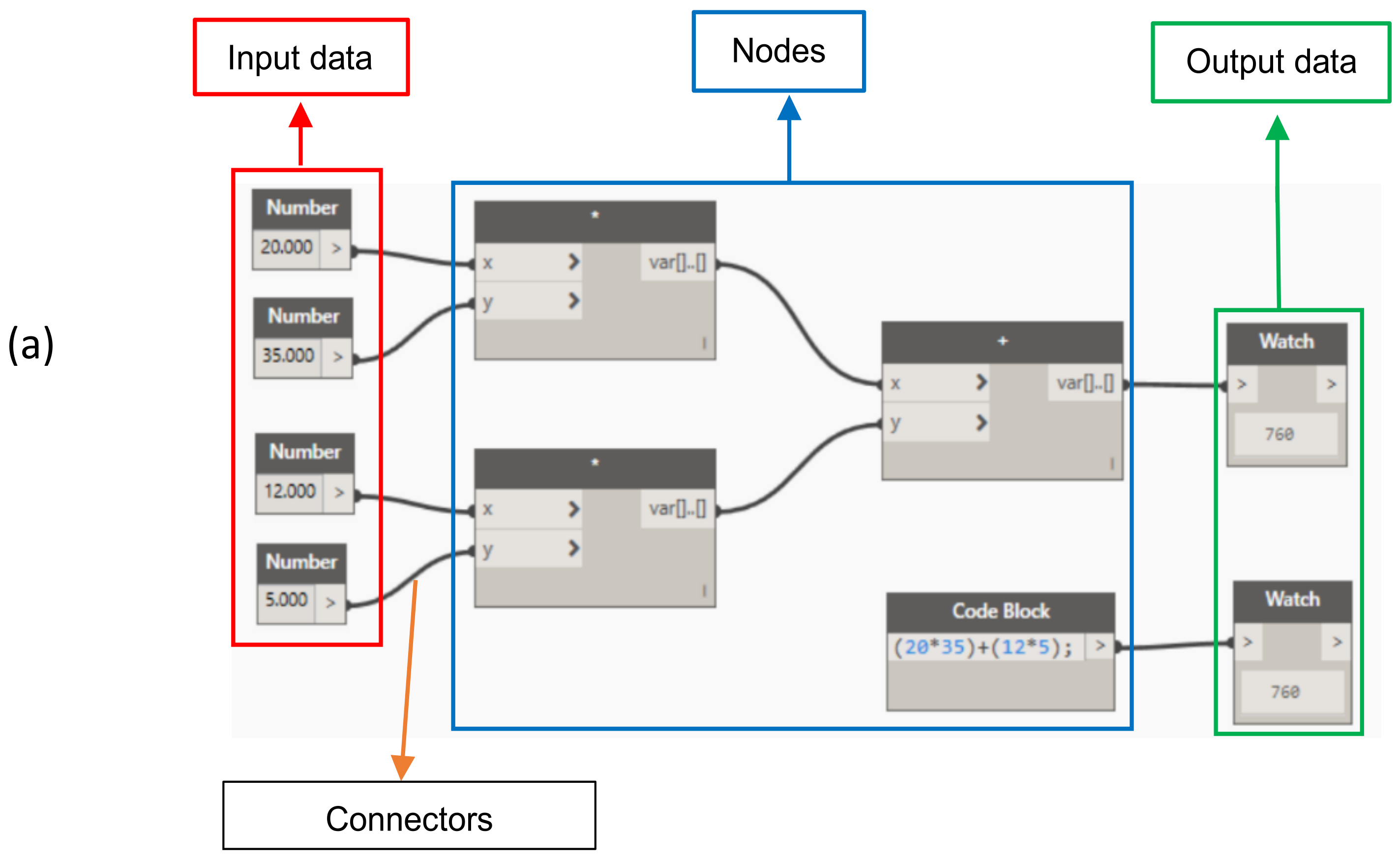
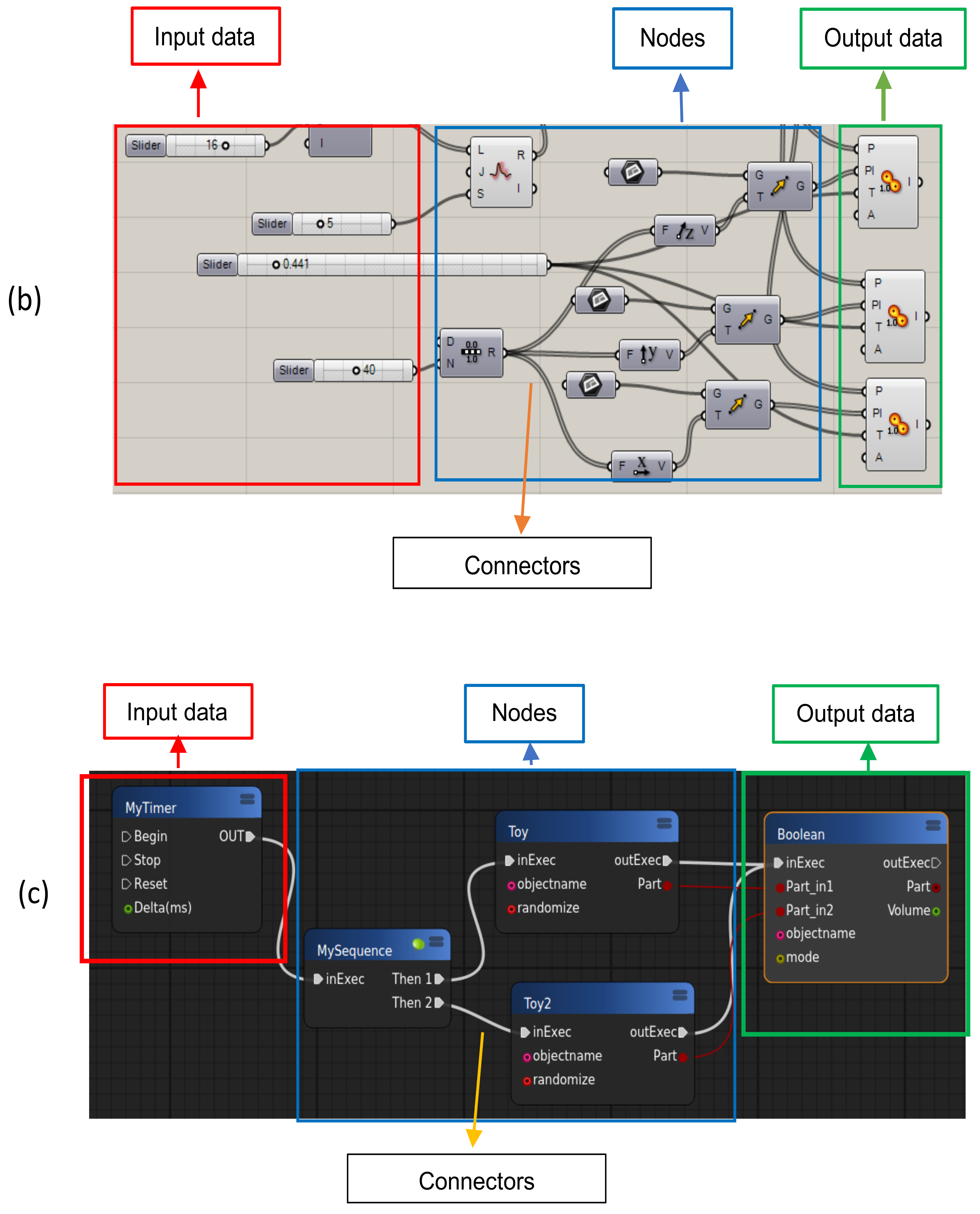
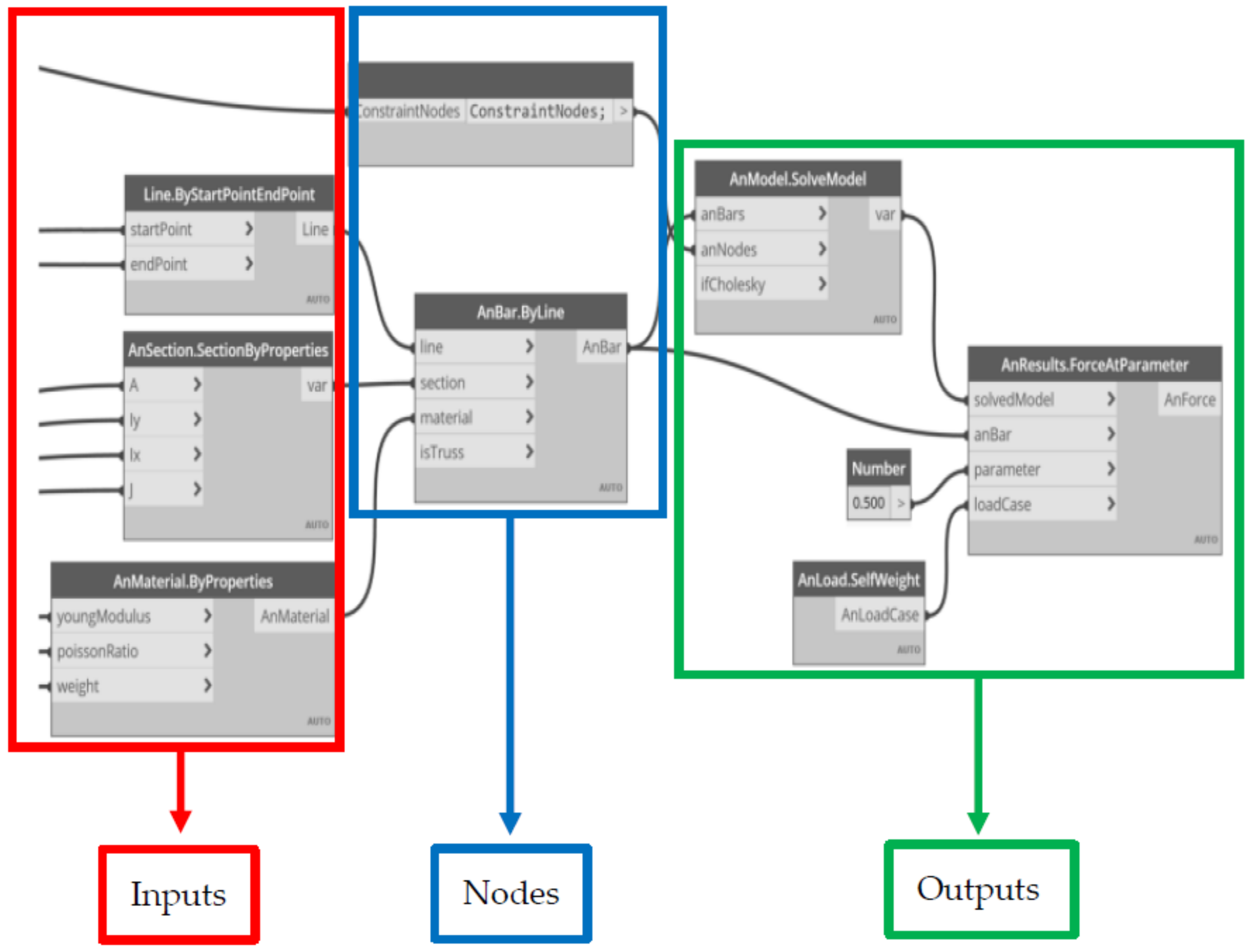
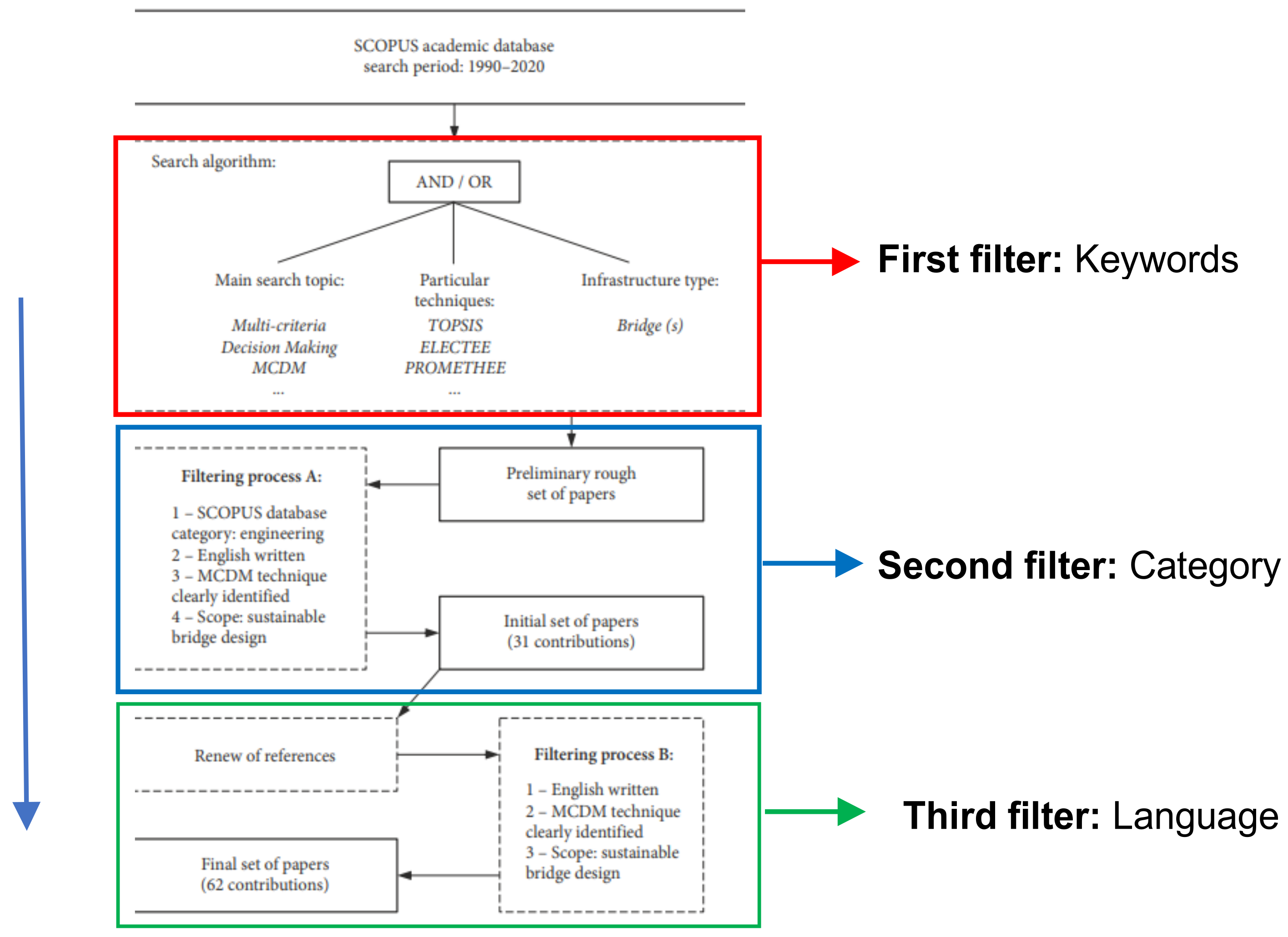
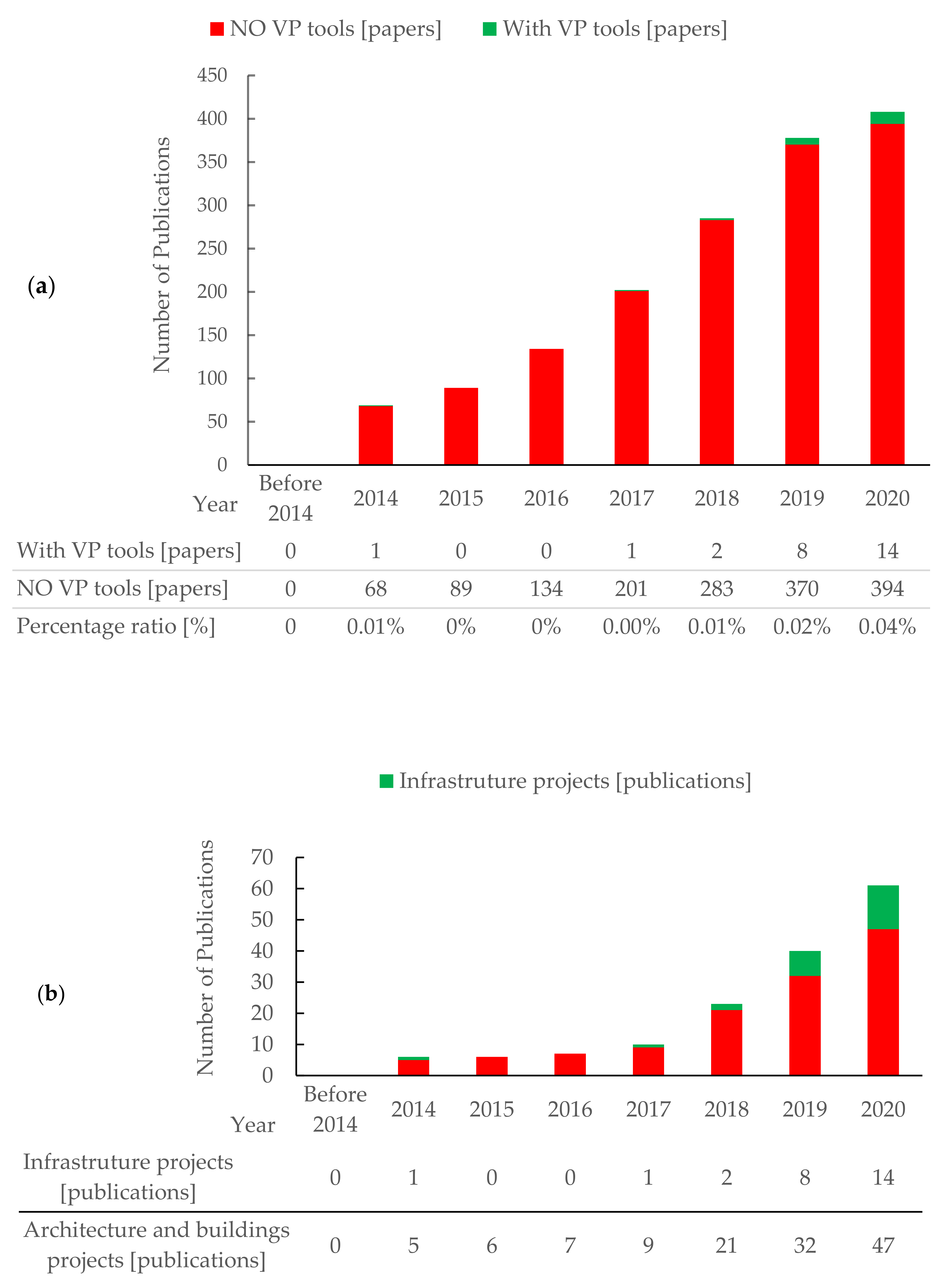
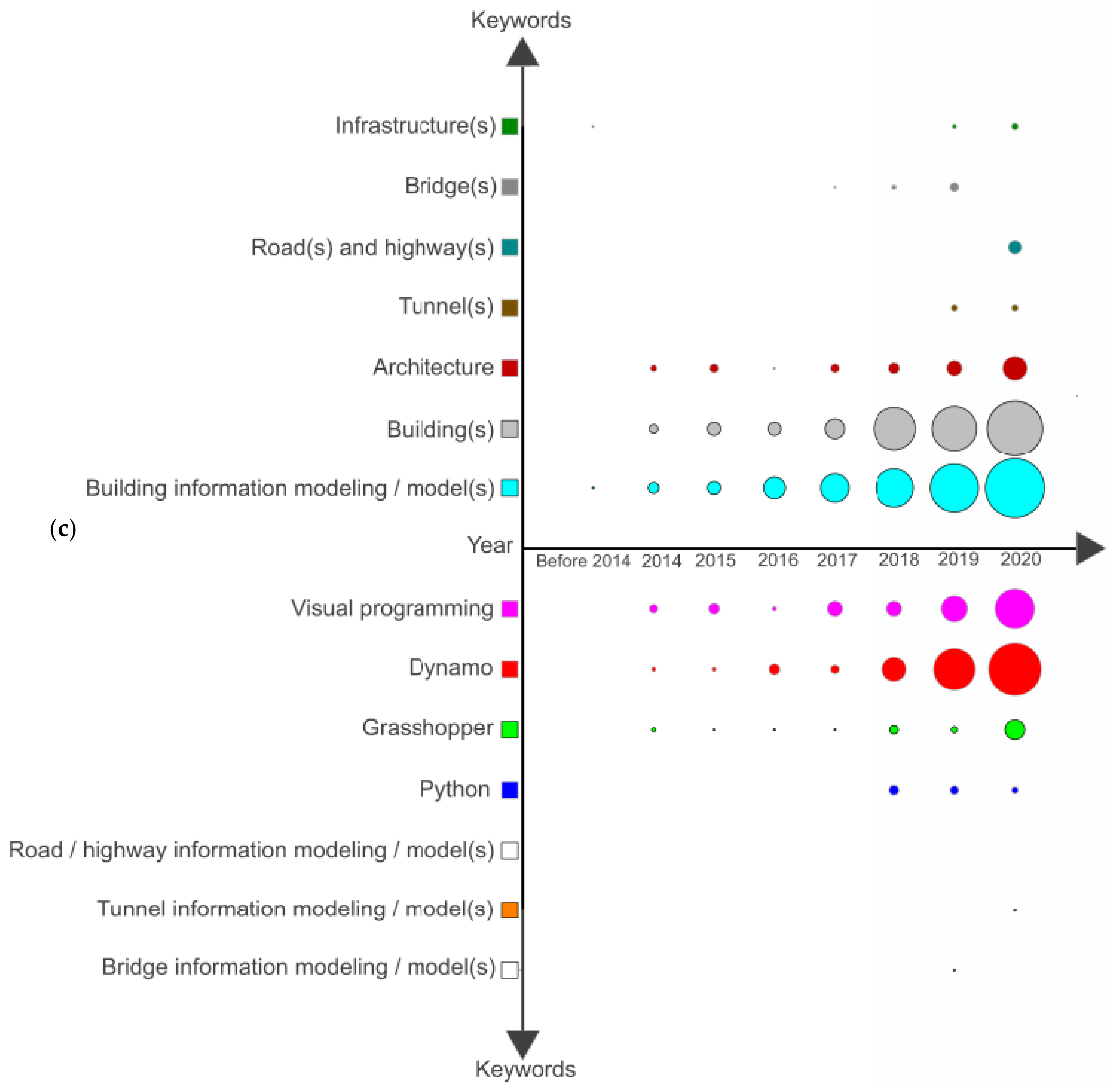


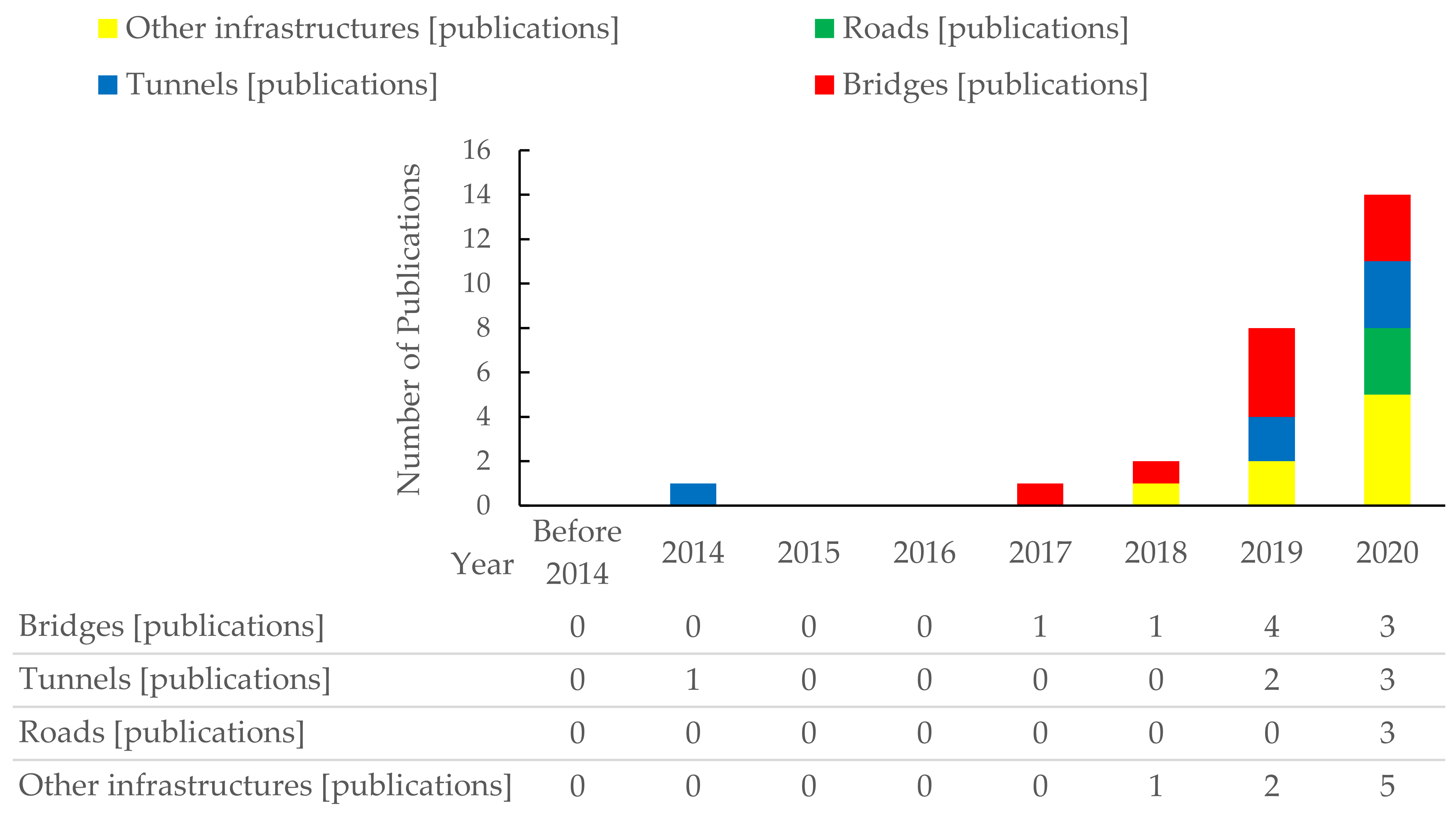

| First Filter | Second Filter | Third Filter | ||
|---|---|---|---|---|
| 1.1 Project type | 1.2 BIM Concepts | 1.3 VP tools | 2. Category | 3. Language |
| Bridge(s) | BIM | VP | Engineering | Only works in English |
| Road(s) | Building information modeling | Dynamo | Instrumentation | |
| Highway(s) | Building information modelling | Grasshopper | Computer science | |
| Tunnel(s) | Building information model(s) | Python | Construction building technology | |
| Architecture | Bridge information modeling | Transportation | ||
| Architectural | Bridge information model(s) | Automation Control | ||
| Infrastructure(s) | Tunnel information modeling | |||
| Building(s) | Tunnel information model(s) | |||
| Road information modeling | ||||
| Road information model(s) | ||||
| Document Type | Number of Works | Percentage [%] |
|---|---|---|
| Patent | 13 | 50.00% |
| Paper | 9 | 34.61% |
| Meeting | 3 | 11.54% |
| Review | 1 | 3.85% |
| Total works | 26 |
| Country | Number of Publications | Percentage (%) |
|---|---|---|
| China | 13 | 50.00% |
| United States | 3 | 11.54% |
| England | 2 | 7.69% |
| Other countries | 8 | 30.77% |
| Institution Type | Institution Name | Country | Reference |
|---|---|---|---|
| Higher education institutions | Technical University of Munich | Germany | [102] |
| Mardin Article University | Turkey | [108] | |
| University College Cork | Ireland | [96] | |
| University of Naples Federico II Federico | Italy | [97] | |
| University of Portsmouth | England | [109] | |
| Chung Ang University | South Korea | [98] | |
| University of Texas Austin | United States | [101] | |
| Hohai University | China | [110] | |
| Southeast University | China | [111] | |
| Tongji University | China | [99] | |
| Beijing University of Civil Engineering & Architecture | China | [112] | |
| Fuzhou University | China | [113] | |
| Changzhou Planning and Design Institute | China | [114] | |
| Zhejiang University | China | [115] | |
| Public entities | Henan provincial communications planning | China | [93] |
| Beijing municipal road and bridge-building | China | [116] | |
| Companies | Shangai baoye group corporation Ltd. | China | [117] |
| Kumming atide software Ltd. | China | [118] | |
| China communications Shangai sanhang TE | China | [119] | |
| Shanghai pudong road and bridge bituminous Ltd. | China | [92] | |
| SGIDI engineering consulting group Ltd. | China | [120] | |
| Sichuan wenchuan maerkang highway LLC | China | [121] | |
| Chengdu engineering management Ltd. | China | ||
| Sichuan gaolu construction consulting Ltd. | China | ||
| Sinohydro Bureau 11 Zhenzhou Ltd. | China | [122] | |
| CCCC first highway engineering Ltd. | China | [94] | |
| China railway engineering group 4 Ltd. | China | [123] | |
| China tiesiju civil engineering group 5 Ltd. | China | ||
| Graphisoft SE | Hungary | [100] | |
| Sambo Engineering Ltd. | South Korea | [124] |
| Project Type | Life Cycle Stage | VP Tool-BIM Software | Reference |
|---|---|---|---|
| Bridge | Operation | Python-API | [99] |
| Operation | Autodesk Dynamo-Revit | [131] | |
| Design | Autodesk Dynamo-Revit | [23] | |
| Design | Autodesk Dynamo-Revit | [118] | |
| Construction | Autodesk Dynamo-Revit | [116] | |
| Design | Autodesk Dynamo-Revit | [92] | |
| Design | Autodesk Dynamo-Revit | [122] | |
| Design | Autodesk Dynamo-Revit | [94] | |
| Design | Autodesk Dynamo-Revit | [123] | |
| Other infrastructures | Design | Grasshopper-Rhinoceros | [108] |
| Operation | Autodesk Dynamo-Revit | [132] | |
| Design | Autodesk Dynamo-Revit | [109] | |
| Construction | Grasshopper-Rhinoceros | [98] | |
| Design | Autodesk Dynamo-Revit | [112] | |
| Design | Grasshopper-Rhinoceros | [113] | |
| Design | Grasshopper-ArchiCad | [100] | |
| Design | Autodesk Dynamo-Revit | [124] | |
| Tunnels | Design | Autodesk Dynamo-Revit | [101] |
| Design | Autodesk Dynamo-Revit | [110] | |
| Design | Autodesk Dynamo-Revit | [93] | |
| Design | Autodesk Dynamo-Revit | [130] | |
| Design | Autodesk Dynamo-Revit | [120] | |
| Design | Autodesk Dynamo-Revit | [121] | |
| Roads | Design | Grasshopper-Dynamo | [97] |
| Design | Dynamo-Python | [111] | |
| Design | Python-API | [116] |
Publisher’s Note: MDPI stays neutral with regard to jurisdictional claims in published maps and institutional affiliations. |
© 2021 by the authors. Licensee MDPI, Basel, Switzerland. This article is an open access article distributed under the terms and conditions of the Creative Commons Attribution (CC BY) license (https://creativecommons.org/licenses/by/4.0/).
Share and Cite
Collao, J.; Lozano-Galant, F.; Lozano-Galant, J.A.; Turmo, J. BIM Visual Programming Tools Applications in Infrastructure Projects: A State-of-the-Art Review. Appl. Sci. 2021, 11, 8343. https://doi.org/10.3390/app11188343
Collao J, Lozano-Galant F, Lozano-Galant JA, Turmo J. BIM Visual Programming Tools Applications in Infrastructure Projects: A State-of-the-Art Review. Applied Sciences. 2021; 11(18):8343. https://doi.org/10.3390/app11188343
Chicago/Turabian StyleCollao, Jorge, Fidel Lozano-Galant, José Antonio Lozano-Galant, and Jose Turmo. 2021. "BIM Visual Programming Tools Applications in Infrastructure Projects: A State-of-the-Art Review" Applied Sciences 11, no. 18: 8343. https://doi.org/10.3390/app11188343
APA StyleCollao, J., Lozano-Galant, F., Lozano-Galant, J. A., & Turmo, J. (2021). BIM Visual Programming Tools Applications in Infrastructure Projects: A State-of-the-Art Review. Applied Sciences, 11(18), 8343. https://doi.org/10.3390/app11188343







